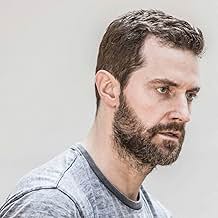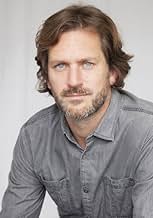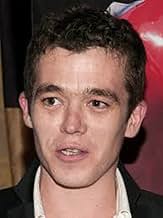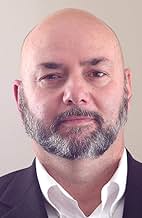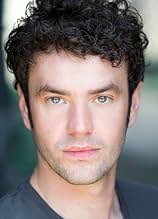IMDb रेटिंग
5.9/10
6.9 हज़ार
आपकी रेटिंग
तेरहवीं शताब्दी के आयरलैंड में, भिक्षुओं के समूह को पवित्र अवशेष को विषम स्थानों के पार ले जाना है.तेरहवीं शताब्दी के आयरलैंड में, भिक्षुओं के समूह को पवित्र अवशेष को विषम स्थानों के पार ले जाना है.तेरहवीं शताब्दी के आयरलैंड में, भिक्षुओं के समूह को पवित्र अवशेष को विषम स्थानों के पार ले जाना है.
- पुरस्कार
- 1 जीत और कुल 3 नामांकन
Akilas Karazisis
- The Killer
- (as Akillas Karazisis)
Gaëtan Wenders
- Fournier
- (as Gaetan Wenders)
फ़ीचर्ड समीक्षाएं
This strong, atmospheric, and beautifully-made little film did not disappoint based on reviews that either put it in the trash for "gratuitous violence" or gave it a firm pat on the head for a good attempt.
I see the value in the latter assessment - working on a budget, this film does a lot with what it has, providing hauntingly beautiful vistas of an ancient Ireland and making its story stretch beyond its small shooting framework. The actors, too, make so much of the script they've been given, with great performances throughout. Although this does lead me onto the main drawback of the film: the characters are largely undeveloped, especially that of Diarmuid - who is the protagonist no less - and his Brothers. We can see that he cares about them a lot - after all, "the monastery is all he's ever known" - but more development would have been crucial to making me really care about whether they lived or died, failed or succeeded. The most interesting characters for me were Geraldus and the Mute, "grey" characters whose backstories are hinted at if never fully disclosed, and with sublime subtlety in the case of Bernthal's character. The characters we do get to truly see are rewarding, albeit darkly, and were one of the film's greatest triumphs - it just would have been great to see the same treatment given to the lead protagonist and primary villain.
In the other camp, I don't think the story could have worked without the levels of violence, savagery, and loss that we see, which the viewer must witness with the same unblinking acceptance that the characters do. In this, there is a hidden depth to Pilgrimage, a story about Ireland, the land where "there was never peace". One review focused around the particular Irishness of the film rang true in some places - that the colour shown here is multiple shades of grey, and little green - if not in others. This is not a deconstruction of the "Irish" mythos, but it does touch, tenderly and reverentially, upon the idea of an unattainable relic: to know peace, both within and without, a dream not limited to this country but echoed in Jerusalem and beyond. Though it does not present its findings in a wholly satisfying parcel, the film did provoke thought about where that quest for peace could lead us next - to what bloody ends or watery graves? To what loss and to what triumphs?
"Where to now?"
I see the value in the latter assessment - working on a budget, this film does a lot with what it has, providing hauntingly beautiful vistas of an ancient Ireland and making its story stretch beyond its small shooting framework. The actors, too, make so much of the script they've been given, with great performances throughout. Although this does lead me onto the main drawback of the film: the characters are largely undeveloped, especially that of Diarmuid - who is the protagonist no less - and his Brothers. We can see that he cares about them a lot - after all, "the monastery is all he's ever known" - but more development would have been crucial to making me really care about whether they lived or died, failed or succeeded. The most interesting characters for me were Geraldus and the Mute, "grey" characters whose backstories are hinted at if never fully disclosed, and with sublime subtlety in the case of Bernthal's character. The characters we do get to truly see are rewarding, albeit darkly, and were one of the film's greatest triumphs - it just would have been great to see the same treatment given to the lead protagonist and primary villain.
In the other camp, I don't think the story could have worked without the levels of violence, savagery, and loss that we see, which the viewer must witness with the same unblinking acceptance that the characters do. In this, there is a hidden depth to Pilgrimage, a story about Ireland, the land where "there was never peace". One review focused around the particular Irishness of the film rang true in some places - that the colour shown here is multiple shades of grey, and little green - if not in others. This is not a deconstruction of the "Irish" mythos, but it does touch, tenderly and reverentially, upon the idea of an unattainable relic: to know peace, both within and without, a dream not limited to this country but echoed in Jerusalem and beyond. Though it does not present its findings in a wholly satisfying parcel, the film did provoke thought about where that quest for peace could lead us next - to what bloody ends or watery graves? To what loss and to what triumphs?
"Where to now?"
Out of the creeping faerie mist of a dark age comes an intensely suspenseful tale about why we choose our allegiances. This is the heart of the story - our reasons make no sense.
The drama revolves around a lump of rock. That any other lump could replace it at any time and no-one would notice is openly stated in the dialogue. It's the stark question woven through the plot - is faith taken on faith alone really worth fighting for?
It's a tense film, beautifully written and exquisitely acted. Each viewer decides what the film's about - it doesn't explain itself, it falls silent. Everyone will see something different. Some might conclude we're all compelled towards war whether we like it or not. Some might decide we're all in league with the Devil whether we know it or not. Some might believe we're all still lost in the creeping faerie mist clutching for something to save us.
Some reviewers didn't rate it highly as an action thriller but it's not a superficial movie and maybe doesn't fit into that genre. There's far more being shown in the subtext and the themes than being told in the action. As for the excessive violence, I felt it merely conveyed the grim reality of melee combat. After all, hidden in the word 'Pilgrimage' is the word 'grim'.
It's a mark of a brilliant film when after seeing it once you must see it again. On the second viewing, it bit me deeper on the neck and made me more its thrall.
For me, the main highlight was Jon Bernthal's acting. It was haunting. He played a voiceless man who served the monks as the lowliest of their group and I fell in love with his tragic integrity. He reminded me of another tormented anti-hero of contemporary myth - Angel from 'Buffy The Vampire Slayer': the vampire cursed with a soul, plagued by a weight of remorse for a hellish past. Both crave absolution and will do anything to receive it.
I loved 'Pilgrimage'. It was a strangely beguiling hybrid of superstitious medievalism clashing with an ancient landscape alive with pre-existing belief. And the ending was satisfyingly unsatisfying - like all good fairy tales are.
The drama revolves around a lump of rock. That any other lump could replace it at any time and no-one would notice is openly stated in the dialogue. It's the stark question woven through the plot - is faith taken on faith alone really worth fighting for?
It's a tense film, beautifully written and exquisitely acted. Each viewer decides what the film's about - it doesn't explain itself, it falls silent. Everyone will see something different. Some might conclude we're all compelled towards war whether we like it or not. Some might decide we're all in league with the Devil whether we know it or not. Some might believe we're all still lost in the creeping faerie mist clutching for something to save us.
Some reviewers didn't rate it highly as an action thriller but it's not a superficial movie and maybe doesn't fit into that genre. There's far more being shown in the subtext and the themes than being told in the action. As for the excessive violence, I felt it merely conveyed the grim reality of melee combat. After all, hidden in the word 'Pilgrimage' is the word 'grim'.
It's a mark of a brilliant film when after seeing it once you must see it again. On the second viewing, it bit me deeper on the neck and made me more its thrall.
For me, the main highlight was Jon Bernthal's acting. It was haunting. He played a voiceless man who served the monks as the lowliest of their group and I fell in love with his tragic integrity. He reminded me of another tormented anti-hero of contemporary myth - Angel from 'Buffy The Vampire Slayer': the vampire cursed with a soul, plagued by a weight of remorse for a hellish past. Both crave absolution and will do anything to receive it.
I loved 'Pilgrimage'. It was a strangely beguiling hybrid of superstitious medievalism clashing with an ancient landscape alive with pre-existing belief. And the ending was satisfyingly unsatisfying - like all good fairy tales are.
A grim and atmospheric film set in 'Dark ages' with noisy action, pursuits, fights and lots of violence. In Middle Age one young monk along with other reckless pals will take on an impressive pilgrimage and will fight against evil. Ireland, 1209. Far from the chaos of the Crusades, a small, quiet group of Catholic monks protect an ancient and powerful relic. However, the object must travel to Rome, as it is required by papal authority, and must be escorted by its protectors, to help the Church in its fight against the infidels. Escorting their monastery's holiest relic to Rome, the monks' progress is seen through the eyes of a pious young novice (Tom Holland), a mute lay-brother (Jon Brenthal) with a violent past and other peculiar priests (Hugh O'Conor, John Lynch, Stanley Weber), all of them go throughout a landscape fraught with peril. This pilgrimage will not be easy, because along the way they will encounter Norman invaders, bloody native tribes and all kinds of unimaginable dangers.
This breathtaking picture packs great loads of action, mystery , twists and turns, overwhelming combats and a little bit of gore and blood. Including stunning battles scenes illuminating the full-blown adventure with a plethora of engaging action set pieces on the thrilling fights. This Middle Age adventure movie deals with a reluctant pilgrimage across an island torn between centuries of tribal warfare and the growing power of Norman invaders, being exceptionally and colorfully cinematographed on location, mostly in Ireland. Beginning with a real sense of wonder including some flashbacks regarding the origin of the holy relic and following with chases, treason, ravage and winding up with continuous struggles and a surprising final. This thought-provoking story deals with God , Devil , Catholic Church and several other 'Age of Darkness' issues. The monks belatedly realize that in this wild land of ancient superstitions, the faith that binds them together may ultimately lead to their destruction. Showing the everlasting and vital value of relics in the time of the Middle Ages, in this case the stone that killed the apostle Saint Matthias while he was apostolate Christian followers in Cappadocia. As the true material, political and religious significance of the bejeweled relic becomes dangerously apparent, their path to the east coast becomes increasingly fraught with danger.
Beautiful scenery, tense and bloody fights and a stirring climax lift this story. This above average and well-directed movie stars Tom Holland (the same year he led his first film for the Marvel Universe: 'Spiderman: Homecoming') who plays a very young monk who will soon discover the savagery that hides behind religious fervour, along with Jon Brenthal, who's pretty good giving life to a silent and mysterious assistant to the monks and he is more than he seems. Completing the cast are: Richard Armitage, John Lynch, Stanley Weber and Hugh O'Connor. The film was nominated for best photography and best costumes at the Irish film and television awards.
Being competently photographed by cameraman Tom Comerford on various locations in Connemara, County Galway, Clonbur, County Galway, County Mayo, Ireland, Roscommon, Ireland, Ardennes, Wallonia, Belgium and Greece. The camera work by Comerford in this film is moving and thrilling. Furthermore, musical score by composer Stephen McKeon is sensitive and spectacular. The motion picture was professionally directed by Brendan Muldowney , though with no originality because we have already seen the pursuit premise of the film in other similar stories. Brendan is an expert filmmaker of all kinds of genres with penchant for horror; known for The Ten Steps (2004), Savage (2009) , Love Eternal (2013), Pilgrimage (2017), The Cellar (2022) , among others . Rating : 7/10. A notable and decent historical film. The picture will appeal to Tom Holland fans. There's something for everyone here ; fans of history , fans of action, fans of medieval adventure should all find something to enjoy about this film. It may not be the best film ever made, but its still one attractive movie.
This breathtaking picture packs great loads of action, mystery , twists and turns, overwhelming combats and a little bit of gore and blood. Including stunning battles scenes illuminating the full-blown adventure with a plethora of engaging action set pieces on the thrilling fights. This Middle Age adventure movie deals with a reluctant pilgrimage across an island torn between centuries of tribal warfare and the growing power of Norman invaders, being exceptionally and colorfully cinematographed on location, mostly in Ireland. Beginning with a real sense of wonder including some flashbacks regarding the origin of the holy relic and following with chases, treason, ravage and winding up with continuous struggles and a surprising final. This thought-provoking story deals with God , Devil , Catholic Church and several other 'Age of Darkness' issues. The monks belatedly realize that in this wild land of ancient superstitions, the faith that binds them together may ultimately lead to their destruction. Showing the everlasting and vital value of relics in the time of the Middle Ages, in this case the stone that killed the apostle Saint Matthias while he was apostolate Christian followers in Cappadocia. As the true material, political and religious significance of the bejeweled relic becomes dangerously apparent, their path to the east coast becomes increasingly fraught with danger.
Beautiful scenery, tense and bloody fights and a stirring climax lift this story. This above average and well-directed movie stars Tom Holland (the same year he led his first film for the Marvel Universe: 'Spiderman: Homecoming') who plays a very young monk who will soon discover the savagery that hides behind religious fervour, along with Jon Brenthal, who's pretty good giving life to a silent and mysterious assistant to the monks and he is more than he seems. Completing the cast are: Richard Armitage, John Lynch, Stanley Weber and Hugh O'Connor. The film was nominated for best photography and best costumes at the Irish film and television awards.
Being competently photographed by cameraman Tom Comerford on various locations in Connemara, County Galway, Clonbur, County Galway, County Mayo, Ireland, Roscommon, Ireland, Ardennes, Wallonia, Belgium and Greece. The camera work by Comerford in this film is moving and thrilling. Furthermore, musical score by composer Stephen McKeon is sensitive and spectacular. The motion picture was professionally directed by Brendan Muldowney , though with no originality because we have already seen the pursuit premise of the film in other similar stories. Brendan is an expert filmmaker of all kinds of genres with penchant for horror; known for The Ten Steps (2004), Savage (2009) , Love Eternal (2013), Pilgrimage (2017), The Cellar (2022) , among others . Rating : 7/10. A notable and decent historical film. The picture will appeal to Tom Holland fans. There's something for everyone here ; fans of history , fans of action, fans of medieval adventure should all find something to enjoy about this film. It may not be the best film ever made, but its still one attractive movie.
Well cast and acted. Visually pleasing and plenty of well performed action. If this is your genre you'll enjoy it
PILGRIMAGE (2017)
This is the new film from the Irish director of the excellent 2009 flick called SAVAGE about an assault on a news reporter in Dublin (and it's aftermath) and I gotta say, if Werner Herzog had made this film rather than one about an Amazonian trek he wudda been quite happy.
The film is set in the early 1200s in Ireland where superstition and the struggle for Christian domination of the country are rife and there, an envoy from Rome is sent to collect a supposedly sacred relic from some rural monks and bring it back to the holy city.
The movie is grim, and conveys the horrible conditions people existed/lived in back then perfectly (the bloody weather looks the same as Ireland has now though haha). It's highly atmospheric, with bleak Irish landscapes, and the acting is top notch with the film basically being a dangerous road trip carrying the relic to a ship that's waiting for them in Waterford (to sail across to France and onward to Rome).
The fact that the film is recorded in Irish, French, and English adds a brilliant realism to proceedings which echoes the situation at the time with Ireland being infringed upon from all sides, and along the way things get very messy and bloody (one death is particularly gruesome).
I'm sure there wasn't a huge Hollywood budget for PILGRIMAGE but they've kept things really concentrated and its certainly exceeds what you might expect to be straight to video cheese.
This is the third film I've seen by Brendan Muldowney and I think the guy has some talent. I will be looking out for his next film and if you haven't already caught SAVAGE Id check that out too.
This is the new film from the Irish director of the excellent 2009 flick called SAVAGE about an assault on a news reporter in Dublin (and it's aftermath) and I gotta say, if Werner Herzog had made this film rather than one about an Amazonian trek he wudda been quite happy.
The film is set in the early 1200s in Ireland where superstition and the struggle for Christian domination of the country are rife and there, an envoy from Rome is sent to collect a supposedly sacred relic from some rural monks and bring it back to the holy city.
The movie is grim, and conveys the horrible conditions people existed/lived in back then perfectly (the bloody weather looks the same as Ireland has now though haha). It's highly atmospheric, with bleak Irish landscapes, and the acting is top notch with the film basically being a dangerous road trip carrying the relic to a ship that's waiting for them in Waterford (to sail across to France and onward to Rome).
The fact that the film is recorded in Irish, French, and English adds a brilliant realism to proceedings which echoes the situation at the time with Ireland being infringed upon from all sides, and along the way things get very messy and bloody (one death is particularly gruesome).
I'm sure there wasn't a huge Hollywood budget for PILGRIMAGE but they've kept things really concentrated and its certainly exceeds what you might expect to be straight to video cheese.
This is the third film I've seen by Brendan Muldowney and I think the guy has some talent. I will be looking out for his next film and if you haven't already caught SAVAGE Id check that out too.
क्या आपको पता है
- ट्रिवियाTo prepare for his role, Jon Bernthal spent the first few weeks of shooting completely silent, even when he's not on set.
- गूफ़सभी एंट्री में स्पॉइलर हैं
टॉप पसंद
रेटिंग देने के लिए साइन-इन करें और वैयक्तिकृत सुझावों के लिए वॉचलिस्ट करें
- How long is Pilgrimage?Alexa द्वारा संचालित
विवरण
- रिलीज़ की तारीख़
- कंट्री ऑफ़ ओरिजिन
- भाषाएं
- इस रूप में भी जाना जाता है
- El sacrilegio
- फ़िल्माने की जगहें
- उत्पादन कंपनियां
- IMDbPro पर और कंपनी क्रेडिट देखें
बॉक्स ऑफ़िस
- बजट
- €47,49,500(अनुमानित)
- दुनिया भर में सकल
- $23,689
- चलने की अवधि
- 1 घं 36 मि(96 min)
- रंग
- ध्वनि मिश्रण
- पक्ष अनुपात
- 2.35 : 1
इस पेज में योगदान दें
किसी बदलाव का सुझाव दें या अनुपलब्ध कॉन्टेंट जोड़ें



